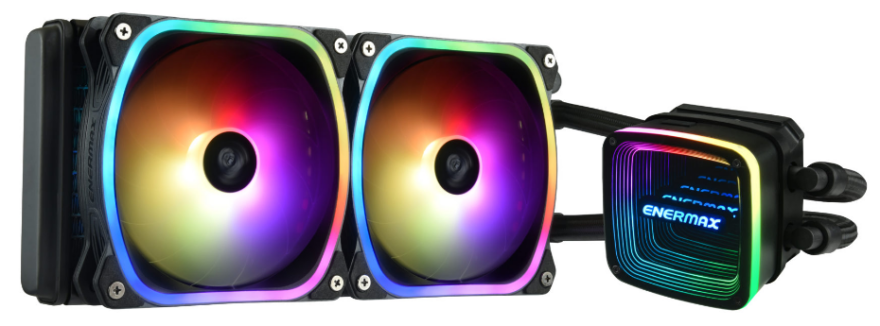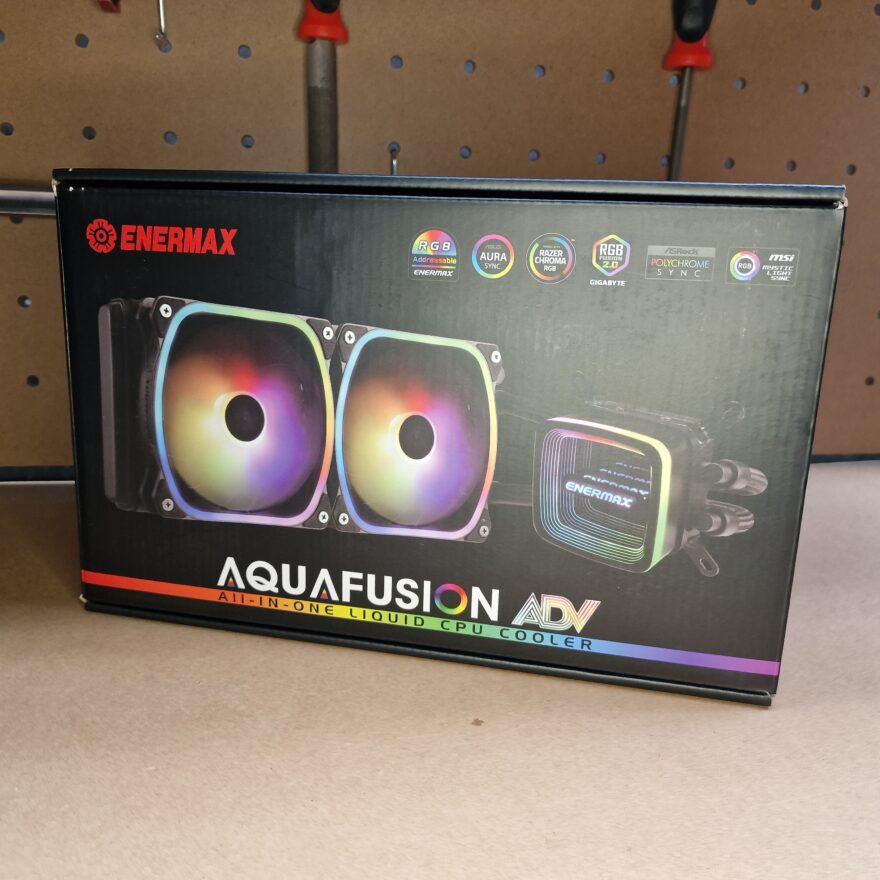Enermax Aquafusion ADV 240mm AIO Cooler Review
Peter Donnell / 1 year ago

Today is a great day, as I welcome Enermax products back to eTeknix! It’s been many years since we worked with this brand, and we’ve got plenty of their products in the office or on the way to test! I remember testing their AIO coolers 10 years ago, and they were by far the best on the market when they decimated the competition with their 120mm and 240mm models. With that in mind, I’m expecting big things from their latest cooler, the AQUAFUSION ADV. Which as the name would suggest, is the advanced version of their extremely popular AQUAFUSION.
Enermax Aquafusion ADV 240
Their latest all-in-one CPU cooler comes in a few sizes and is available in black and white. However, today, I have the black 240mm version! Equipped with its patented dual-chamber design, it promises better performance and reliability, with broad support for the latest AMD and Intel sockets. It comes equipped with a pair of ENERMAX SquA ADV RGB fans too.
Features
- Dual-Chamber Design – A Patented Dual-Chamber Mechanism that isolates the pump from the heat, significantly increases the cooler’s lifespan without compromising efficiency.
- Patented CCI + SCT Technology – Central Coolant Inlet (CCI) technology injects the coolant at the hottest spot to prevent heat surges. Shunt-Channel Technology (SCT) design shortens the coolant flow path, resulting in faster heat transfer.
- ENERMAX SquA ADV Fans – With our Vortex Frame Technology and a downsized hub design, ENERMAX SquA ADV fans provide optimal cooling performance.
- Addressable RGB Lighting Synchronization – AQUAFUSION ADV is designed to synchronize to addressable RGB motherboards (3-pin assignment is 5V/D/G) which users can program preferred lighting effects via motherboard software.
- Motherboard Synchronization – Coordinate your visual effects through supported RGB software and motherboard synchronization to access control for customized lighting effects.
- ENERMAX RGB Control box – Preset 10 lighting effects; use the attached ENERMAX RGB control box to select your preferred lighting mode, brightness and speed.

What Enermax Had to Say
“AQUAFUSION ADV is the next generation of all-in-one CPU liquid cooler with pre-filled coolant. This makes a liquid cooler as simple as a regular air cooler. Easy installation and no maintenance. The fully sealed design ensures minimal liquid evaporation and long lifespan. With lively lighting effect and efficient cooling, AQUAFUSION ADV is best for case mods and gaming systems.” – Enermax
Launch Trailer
A Closer Look
First up, let’s take a look at the new fans. They’re pretty unique looking with a sort of squared circle look about them that I really like. They are ARGB fans and have a frosted fan blade design that will illuminate, but also a thick ring of lighting on the outer frame too, for double the fun.

The fans feel quite robust with thick frames and it’s like they’re built from multiple layers, with these ridges down the side that will add to their overall strength, while reducing the need for more plastic by filling this area in entirely.

There are anti-vibration rubber mounts on all four corners, and on both sides too, so you’ll get the effect of them regardless of their orientation.

One thing that really stands out, however, is the back of the fan, which has thirteen thin blades that act as the frame support and motor mount. I’ve never seen a fan design like this and obviously, it looks like it’ll provide minimal air resistance too, which is always a good thing. The fans themselves feature a 9-blade fan design. They’re designed to run at 500 to 2000 RPM. However, there’s a low-noise adaptor included to bring that down to 1700 RPM should you need it.

Moving on to the pump, it’s quite compact design despite using a dual-chamber design, being not much larger than the copper cold plate on the bottom, which is actually quite large itself though, and should provide excellent coverage for even the larger over the supported CPUs.

It supports all major AMD and Intel sockets (see list below), with brackets that simply screw onto the side of the pump. The pump itself uses a ceramic bearing, with a 50,000 hours MTBF, which is nearly 6 years of constant usage.
- Intel® LGA 1700/1200/115x/2066/2011/2011-3/1366
- AMD® AM5/AM4/AM3+/FM2+/FM1

The top of the pump has a gorgeous mirror finish to it, which I think looks amazing when it’s not turned on. However, there’s some ARGB lighting under it, which you’ll see in action shortly.

The radiator is a 240mm design, and it comes with a pretty densely packed aluminium fin array that allows it to deal with an impressive 360W TDP. It also comes with support to mount the fans on either side, giving you more flexibility when you come to install it.

The tubing is good quality with a nice and durable black weaving that both protects it, and looks great too. There’s also black sleeving on the PWM connector for the pump.

Test System & Methodology
Idle tests are recorded after 10 minutes of the system being left alone after boot with no additional background processes or software running. All load tests are performed in Cinebench R2, first using a single speed run to generate the Cinebench R23 score, then a 10-minute loop to determine the overall all-core average load temperature for the relevant cooler.
Clock speeds are left at the default factory settings provided by the CPU and our NZXT Z690 N7 motherboard. Optimised settings lock the CPU P-Cores to 4.9Hz and the E-Cores to 4GHz at a voltage of 1.3v. Fan speeds for the case are set to 30% at all times. Pump RPM is fixed to 100% for liquid coolers, and CPU cooler fans are left to the motherboard “automatic” and “normal” profile unless otherwise stated.
Acoustics are measured from 2ft above the NZXT H7 Flow PC case, using a decibel meter, with all side panels and filters in place on the case and as stated, the case fans are left at 30% (just to the point where they become comfortably audible over ambient), to represent a real-world usage scenario. We are no longer testing coolers on an open-air test bench for this reason.
As of 20/07/2023, all coolers featured on these charts were retested to reflect our improved methodology, and as such, reviews prior to this date can not be fairly compared to the new results. However, we have been periodically retesting older coolers, which is why you may see their performance figures here, and why they may not align with previous test results from the same product in their respective reviews.
Test system:
- NZXT Z690 ATX
- Intel Core i9-12900K @ stock and & 4.9 GHz all P-Core 4 GHz E-Core 1.3v
- Aorus RTX 2080
- 16GB Crucial DDR4 4400 MHz XMP
- 512GB NVMe SSD
- Thermaltake Tough Power 750W
- NZXT H7 Flow RGB Case
- All testing is conducted using NT-H1 thermal paste
We want to thank Gigabyte, Noctua, Crucial, Intel, Thermaltake, NZXT and more for providing us with the above testing equipment and their ongoing support.
Testing Methodology
- We always use Noctua Noctua NT-H1 thermal paste to make sure testing reveals the efficiency of the tested coolers not the efficiency of the bundled thermal paste
- Cinebench R23 is run for 10 minutes to calculate “load” results
- Multiple readings are taken with the average of the package temperatures calculated for our recorded result
- Fans are left to operate at default PWM profile speeds unless otherwise stated
- For water cooling tests, all pumps have been operated at 12 volts unless otherwise stated
- Ambient temperatures should be between 21-23 degrees in all our tests unless otherwise stated
- Acoustic measurements are taken 60cm vertically away from the CPU cooler
- Stock tests are performed using “out of the box” settings for the CPU
- All coolers were tested under identical settings unless otherwise stated.
- There is approximately a 1-degree Celsius margin of error in our temperature recording software CPUID HW Monitor
- There is approximately a 1.5dBA margin of error with our Benetech GM1351 decibel meter
- In all these graphs we may have a few “reference” results of particular products that do not fit within that category for comparative purposes.
Software Used
- CPUID HWMonitor
- Cinebench R23
- Unigine Superposition
Performance

It looks stunning with that 80s neon retro vibe from the infinity mirror ARGB lighting! The ARGB fans look great too, with their outer rim lighting and illuminated fan blades, giving you plenty of ARGB customisation should you need it.

Temperatures
At stock, the temperatures are great, pretty average on our charts, but hey, there’s a lot of really great coolers on our charts!

Optimisation really pushed things to the next level, with performance matching the Kraken 240 AIO, which costs three times as much (mostly due to its LCD display).

Acoustics
The fans are whisper quiet at idle, and a little on the louder side at full load, but honestly, they’re strong fans and dropping the RPM to a silent profile does pretty much nothing to the cooling performance.

Optimisation helped though, peaking at just 48 dBA.

CineBench R23
Right out of the gate, it delivered one of our strongest Cinebench scores at 26533.

However, with our optimised settings, it even managed to beat out the TH420, and well… everything else. So clearly, CPU performance is pretty fantastic with this cooler.

How Much Does it Cost?
The Enermax Aquafusion ADV 240mm AIO is available now from Amazon in black for just £101.10, or in white, for £87.46. I suspect that the under £90 price is more correct and that the black one, at the time of writing, is higher as it’s showing as an EU import to the UK, so be sure to shop around for a good price, or just buy the significantly cheaper white one!
Overview
Enermax is a brand I’ve long missed here at eTeknix, and it’s great to see them back in this UK market and eager to work with us. This cooler is a great starting point too, as it comes in at a competitive price point (under £90 if you shop around), which makes it around £20 cheaper than the similarly equipped rival products from NZXT, DeepCool, and CoolerMaster, to name but a few. You can get something a little cheaper, but the TDP will be lower and there will be less ARGB trickery to play with.
The build quality is great, I can’t say I have any problems with the fans or the pump construction, but perhaps aesthetically some of the plastics do look a little cheaper or shiny to my eye. It’s a more retro-looking plastic, and while there’s nothing wrong with that at all, it’s just an observation and most fans use a more matte finish and smoother-looking plastic these days.
The fan design is great though, and I really like the fins design on the back that directs the airflow and also doubles as the motor mount. They’re rather thin fins, but that’s likely why there are thirteen of them to provide the support needed for the fan. By comparison, most fans use three thick bars to support the motor, not thirteen thin ones. They can be a little loud at full RPM, but their airflow is powerful enough that turning them down to 40% RPM results in virtually unaffected cooling and quiet performance.
As for the performance, Enermax promises one of the highest TDPs in the 240mm AIO class of coolers. Promising a 360W TDP, while something like the DeepCool LS520 SE promises 280W. What shocked me was that not only did it deliver competitive temperatures, but it also scored highest on Cinebench, which was quite a surprise. I think this is due to the good quality copper contact plate and pump, as it can very easily mitigate any temperature spikes from the CPU, keeping the performance figures very high, which is obviously a good thing.
Should I Buy One?
Compact, surprisingly affordable, and with excellent cooling performance, this is a great product. The fans likely don’t need to spin up so hard though, and a more gentle fan curve would be nice, but overall there’s really nothing I can fault about the Enermax Aquafusion ADV 240mm AIO Cooler.




















